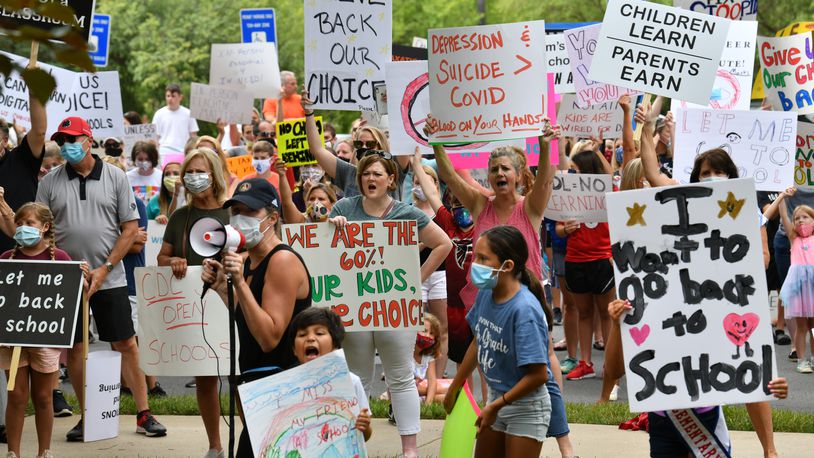School choice expansion proposal pushes too far
Hyosub Shin / Atlanta Journal Constitution (Creative Commons)
Parents angry at return-to-school policies and controversial decisions made by public schools have embraced school choice as a way to hold districts accountable, co-opting the idea of school choice for their own ends.
April 14, 2022
The issues of COVID-19 safety measures and racial justice that have dominated the news in recent years have shed new light on the public school system, fueling potential long-term impacts in the education sphere. Namely, this has manifested itself in the form of an increased emphasis on school choice.
School choice is a broad term for education options that offer families the ability to enroll in schooling outside of their designated public school, allowing students to receive the instruction that best suits their needs. This idea sounds great on paper. School choice programs have been touted as giving parents greater freedom and power in their children’s education, holding schools accountable and creating a more level playing field by assisting lower-income students in attending higher-quality schools.
But in practice, although school choice policies can successfully work towards these aims, school choice has instead become an increasingly popular talking point for the wrong reasons.
Atlanta Public Schools currently has its own school choice system, which allows students to apply to schools outside of their designated school zone, although some schools such as Midtown are not currently accepting transfers due to a lack of additional student capacity. This district-wide program aims to give parents and families additional schooling options while still keeping students in the district and the public school system. In recent years, APS has turned to charter schools and outside organizations as a means for salvaging under-performing schools. While charter schools have been met with their share of criticism, they serve as another beneficial way of providing tuition-free alternative options for parents while also improving schools within the district.
The push for school choice across the country has not stopped with providing student transfer opportunities within public school districts or chartering failing schools. The nationwide outrage against pandemic-related safety measures such as mandating masks for students, critical race theory and other culture war issues has fueled parents’ anger towards public schools. School choice has been seen as a way for parents to hold schools accountable for these controversial decisions.
One school choice policy gaining traction is school vouchers. These programs allow families to use public funding that would otherwise fund their childrens’ education in public school districts to instead fund their childrens’ education in a private school of their choice. In addition to putting lower-income schools at an even greater disadvantage by diverting money from school districts that need it the most, school vouchers raise questions about the separation of church and state, as these programs often allow parents to use public funding to enroll their children in private religious schools.
Most importantly, school vouchers do not help the families who need it the most. Two bills have been proposed in the Georgia House of Representatives that would provide $6,000 a year vouchers for students to use towards private school tuition, and other school voucher programs across the country offer subsidies of similar value. However, the annual tuition of most private schools is much greater. For example, Georgia private schools Paideia and Woodward have high school tuition of $28,875 and $31,150 respectively, meaning that parents looking to enroll their children in these schools would have to spend upwards of $20,000 a year, even with a voucher. The reality is that many of these voucher programs only cover a small portion of the cost, leaving lower-income families unable to make use of the supposed benefits being provided to them.
School choice should be used exclusively in conjunction with public school districts to support students in low-income communities and assist under-performing schools, providing tuition-free access to higher-performing public schools like Midtown without stripping funding from districts that need it.
Instead, school choice has increasingly become a rallying cry for parents upset with public school decisions who want to send their children to private schools. Proponents of expanded school choice policies need to realize that a $6,000 school voucher is not opening as many doors as they may think. Rather, these unjustified expansions of school choice policies only weaken public school systems, leaving behind the students who need support the most, rather than lifting them up.







